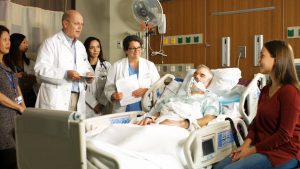
This collection of self-study modules covers essential components of patient-centered heart failure clinical practice. They provide a framework for healthcare professionals and students interested in learning about up-to-date guidelines for heart failure care. Developed through an academic-practice partnership between the University of Washington (UW) School of Nursing (SON) and UW Medicine’s Regional Heart Center (RHC), topics covered in this series were specifically chosen to enhance clinical practice and improve heart failure outcomes throughout the Washington, Wyoming, Alaska, Montana, and Idaho (WWAMI) region and beyond. The self-paced modules are freely accessible and may be completed in any order. Additional modules will be added as they are completed.
Communication & Decision Making in Advanced Heart Disease
Learn how to conduct discussions about goals of care and share decision making with patients and their families Learning Objectives:
- Define advanced heart failure (HF), goals of care discussion, and shared decision making.
- Outline the trajectory of HF illness and anticipated decision points.
- Identify triggers for goals of care conversations.
- Recognize potential barriers to patient-provider communication in advanced HF.
Detecting & Evaluating Cognitive Impairment in Heart Failure Patients
Strategies for implementing screening and care management approaches for patients with cognitive decline. Learning Objectives:
- Become familiar with prevalence of cognitive impairment in Heart Failure patients.
- Understand how to screen for cognitive impairment.
- Learn how to administer, score and interpret results of the Mini-Cog™, AD8 and PhQ-2 screening instruments.
- Rule out comorbidities and identify contributing factors that may affect cognition in heart failure such as cardiovascular pathology, medications, or the presence of depression.
- Disclose clinical findings to patients and families.
- Formulate diagnosis, treatment plan and initiating referrals.
The Role of Home Telehealth in Care Delivery for Heart Failure
Overview of telehealth including definitions, current guidelines, and anticipated health benefits Learning Objectives:
- Define telehealth terminology.
- Describe the history of telehealth.
- Discuss current guidelines and anticipated benefits for home telehealth.
- Analyze effective telehealth in a person with heart failure.
Depression in Heart Failure
Understand the risk for depression in heart failure and identify screening and treatment options Learning Objectives:
- Describe key symptoms of depression and tools used in assessment of depression in Heart Failure (HF).
- Identify treatment options for patients with depression and HF.
- Describe interprofessional team roles for treatment of depression in patients with HF.
Management of Acute Heart Failure from Admission to Transition
An unfolding case study about the management of an adult in the midst of a health crisis Learners are presented with information as the providers learn of the patient’s emergent and ongoing health concerns, and asked to make decisions about how to care for this patient. Authors: Angela D. Pal, PhD, RN, ARNP; Hilaire J. Thompson, PhD, RN, ARNP; Joelle T. Fathi, DNP, ARNP; Phyllis Christianson, MN, ARNP; Leigh Ann Mike, PharmD, BCPS; Megan Moore, PhD, MSW; Janet Lenart, RN, MN, MPH; Kumhee Ro, DNP, ARNP; Patricia Kritek, MD, EdM; Marni Levy, BS © 2017 University of Washington | School of Nursing | L&IT Interactive Production Web Services GO TO MODULE
Identifying Bias in Clinical Settings
Learn about implicit bias, its impacts on healthcare and strategies to reduce those impacts Learning Objectives:
- Define implicit and explicit bias
- Identify how bias operates in clinical settings
- Apply strategies to mitigate impact of bias
Population Health
Learning Objectives:
- Define population health and population health management.
- Summarize the benefits of population health strategies for improving heart failure outcomes.
- Identify the key steps involved in creating a population health intervention for heart failure.
Living Well with an ICD
An overview of changes physical and mental functioning following the implantation of an ICD and strategies to cope with these changes. Learning Objectives:
- Discuss physical functioning and psychological adjustment following an ICD.
- Explore cognitive and relationship challenges following an ICD.
- Suggest helpful strategies to the patient to enhance adjustment following an ICD.
Transitions of Care
Co-develop a plan of care for a heart failure patient’s transition from hospital to home with the patient, his family and other transition team members. Learning Objectives:
- Identify challenges that patients with advanced heart failure face transitioning from hospital to home.
- Describe the role and responsibilities of team members involved in the transfer of the patient from hospital to home.
- Apply evidence-based methods to improve care coordination, patient safety and clinical outcomes.
Acknowledgements
The Heart Failure Care Management Modules are supported by the Health Resources and Services Administration (HRSA) of the U.S. Department of Health and Human Services (HHS) as part of an award totaling $2,090,495 with 0 percentage financed with non-governmental sources. The contents are those of the author(s) and do not necessarily represent the official views of, nor an endorsement, by HRSA, HHS or the U.S. Government.
